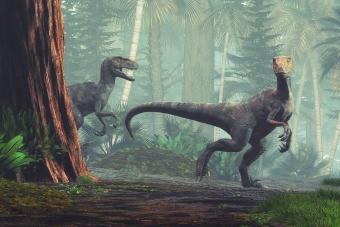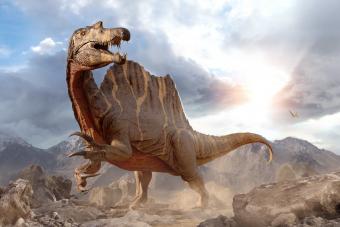
The most popular dinosaurs are the ones that Hollywood has made famous, so most of the names on this list might not surprise you. But how much do you actually know about these giants of the big screen? Bet you didn't know that one of these famous figures isn't even a dinosaur! How about the fact that some of these reptiles were warm-blooded?
If you're enthralled with these enormous creatures, then keep scrolling to find out some surprising facts about the ferocious fascinations of our imaginations! Like any popularity contest, it's a little tricky to choose favorites, but these show up on lists from the National Park Service and the American Museum of Natural History.
Tyrannosaurus Rex: The Warm Blooded Dinosaur

Arguably the most famous of all the dinosaurs, the Tyrannosaurus Rex, often referred to as T-Rex, tops our list of the most popular dinosaurs. Its fame stems from its terrifying reputation as a top predator. Their massive size, fearsome teeth, and comically short arms have immortalized the king of dinosaurs in pop culture, most notably in movies like Jurassic Park.
Fun Fast Facts:
- Tyrannosaurus Rex means 'tyrant lizard king' in Greek.
- New research shows that the T. Rex's toothy grin may be inaccurate. They now theorize that this massive monster had lips that covered its large pearly whites!
- T. Rex was a warm-blooded animal.
- The life expectancy of T. Rex was around 28 years.
If you want to see a Tyrannosaurus Rex in all its glory, you can find the largest and most complete specimen at the Field Museum in Chicago. This fossil's name is Sue. However, scientists do not actually know if the creature was male or female.
Triceratops: The Last Dinosaur Standing

Another familiar face in the dinosaur world, the Triceratops, is known for its distinctive three-horned face, bird-like beak, and the large frill around its head. This herbivore's unique appearance and the mystery surrounding its horns' purpose - defense, mating rituals, or something else - have made it a favorite among dinosaur enthusiasts.
Fun Fast Facts:
- Triceratops fittingly means 'three-horned face' in Greek.
- This dinosaur is the official state fossil of South Dakota.
- The Triceratops were likely the last living non-avian dinosaurs when the meteorite hit Earth.
Velociraptor: The Dinosaur Jurassic Park Lied to You About

The most popular dinosaur in the Jurassic World saga is the cunning Velociraptor named Blue. While real Velociraptors were much smaller (about the size of a wolf) and likely feathered, their portrayal in pop culture as intelligent and agile predators is right on point.
Fun Fast Facts:
- Velociraptor means 'swift thief' in Greek.
- Jurassic Park was wrong - studies show raptors likely hunted solo.
- The most famous Velociraptor fossil comprises a Velociraptor and a Protoceratops forever locked in combat. It is called 'The Fighting Dinosaurs' and it's considered a national treasure of Mongolia where it was found.
Brachiosaurus: The Gentle Giant

With a giraffe-like neck, it's hard to forget the Brachiosaurus! This gentle giant could reach heights of up to 40 feet, the size of a 4-story building, and lengths almost double that! These herbivores also had quite the appetite, eating up to 900 pounds of food a day. It's no surprise that there's a fascination surrounding these majestic creatures!
Fun Fast Facts:
- Brachiosaurus means 'arm lizard' in Greek.
- These massive creatures could weigh in at 99,000 pounds when full grown.
- Their poop was also massive - estimated at 3,000 pounds.
Stegosaurus: The Rock Eater

You know them by their signature rows of large, kite-shaped plates along their back and their powerful spiked tail. The Stegosaurus, while widely shown in cinema, is actually quite illusive on Earth. There have only been 80 specimens found across the globe. From these fossils, scientists have found that this large dinosaur, which could reach 20 to 30 feet in length, had a teeny tiny brain about the size of a dog!
Fun Fast Facts:
- Stegosaurus means 'roof lizard' in Greek.
- The remains of this creature are the official state fossil of Colorado.
- These herbivores likely ate small rocks to help digest some of the tougher plants in their diet. This is because they had very few teeth and a bite force comparative to a sheep.
Pterodactyl: The First to Achieve Powered Flight

Did you know that the Pterodactyl is not actually a dinosaur? While a close cousin to the dinosaurs, it's officially classified as a flying reptile. Another misnomer relates to their size. Paleontologists have found that "some were as large as an F-16 fighter jet, and others as small as a paper airplane."
In other words, these animals could reach the height of a giraffe! Another pt-errific fact about one of the most popular dinosaurs is that their wings are similar to those of a bat and not a bird.
Fun Fast Facts:
- Pterodactyl means 'winged finger' in Greek.
- These were the "first animals after insects to evolve powered flight."
- This dinosaur's most popular in Kansas, serving as their official flight fossil.
Spinosaurus: The Largest Carnivorous Dinosaur

Spinosaurus is probably the least recognizable dinosaur on our list, but it's also the largest carnivorous dinosaur to have ever lived on Earth. This semi-aquatic carnivore has a crocodile-like skull filled with a terrifying set of teeth that reached up to half a foot in length. It also had a massive sail-like spine, making for quite the terrifying sight.
Fun Fast Facts:
- Spinosaurus means 'spine lizard' in Greek.
- Although this dinosaur was larger than T. Rex, paleontologists believe its diet was primarily large fish.
- Scientists have discovered that while this creature likely waded in shallow water, "in deep water [the Spinosaurus] was an unstable, slow-surface swimmer (<1 m/s) too buoyant to dive."
Ankylosaurus: The Tank

Ankylosaurus, often referred to as the 'tank of dinosaurs,' is known for its heavily armored body and massive club-like tail. Slightly similar in appearance to the horny toad of the present day, this well-protected plant eater was quite large, reaching lengths of approximately 30 feet! However, despite its large size, it only moved at about three miles per hour.
Fun Fast Facts:
- Ankylosaurus means 'fused lizard' in Greek.
- The only weak spot of the Ankylosaurus was its underbelly.
- Africa's first Ankylosaurus was just discovered in 2021 and this specimen is the first of its kind to have its spiked dermal armour fused to its skeleton.
Sign up for our newsletter featuring all the latest stories and products we love.
Parasaurolophus: The Trumpet Player

You may not be familiar with the name, but you most certainly know their unique heads! The Parasaurolophus is one of the most recognizable dinosaurs thanks to its long, backward-extending cranial crest. The mystery surrounding the purpose of this physical feature - from social signaling to sound amplification - adds to its intrigue.
Fun Fast Facts:
- Parasaurolophus means 'near crested lizard' in Greek.
- The crest of the Parasaurolophus contained tube-like holes that make trumpet-like noises.
- Scientists consider this creature a duck-billed dinosaur because of its distinct facial features.
Diplodocus: The Dinosaur With No Brains and a Big Whip

This peaceful plant-eater looks similar to the Brachiosaurus on our list, but it's much longer. In fact, scientists note that the Diplodocus is one of the longest dinosaurs ever discovered, reaching an impressive 92 feet. However, this is another dinosaur with a very tiny amount of intelligence. Scientists estimate that its brain only weighed a mere four ounces!
The human brain weighs approximately three pounds, or 48 ounces.
Fun Fast Facts:
- Diplodocus means 'double beam' in Greek.
- This creature's front legs were shorter than their back legs, which hints that this dinosaur ate vegetation that was low to the ground.
- Computer models show that the long tails of dinosaurs like Diplodocus "could reach supersonic velocities, producing a noise analogous to the 'crack' of a bullwhip."
Dinosaurs Teach Us About Our Future

Dinosaurs are fascinating creatures that do much more than entertain us. They also teach us about the world's climate and how change is normal. Scientists note that "the best way to look ahead is to look behind, at those organisms, including dinosaurs, that survived extended climate change." If we want to better understand our impact on climate change, we must first investigate the shifts that occurred before we existed.
Interestingly, another way we learn about climate change is by studying one of the most desolate places on Earth - Antarctica. If you want to learn more, check out our interesting facts about the coldest, windiest, and driest place on the planet!







